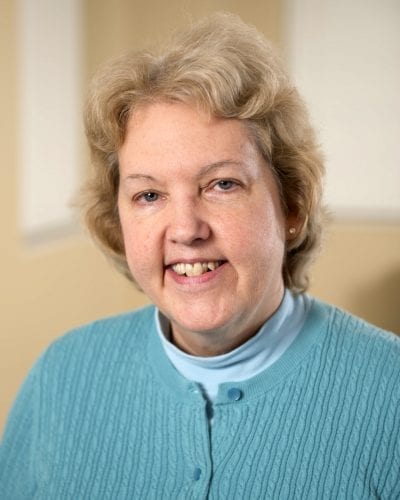Kathy Mercuris taught every DMU physical therapy graduate until her retirement in 2020.

Kathy Mercuris, P.T., D.H.S., knew since her youth that she wanted to work in a helping profession. When she watched a child being assisted by an adult on actor/comedian Jerry Lewis’ Muscular Dystrophy Telethon and realized that person was a physical therapist, that set her career path. “I can’t think of anything I would have loved doing more than physical therapy,” she says.
Mercuris, who retired as an associate professor of physical therapy in 2020, was part of an evolving profession and program at DMU. After practicing at Northwestern Memorial Hospital for two years and then at Iowa Methodist Medical Center’s Younker Rehabilitation Center for 10, she joined the University’s physical therapy program as an instructor in 1988, the year it began admitting students.
“Three of us faculty came directly from clinical practice. We didn’t know anything about academia,” she recalls. Fortunately, physical therapy and teaching go hand in hand, and she had often supervised students while at Younker Rehabilitation.
“I think all physical therapists are teachers. We teach our patients on how to move and do functional activities. We teach their families and help them adapt,” she says. “I felt that I had a skill set and knowledge to share. Doing so in a classroom setting, I could touch more people than with students on rotation.”
Physical therapy has existed as a profession since the early 1900s; early on, people needed only two years of education to practice it. The requirements increased to a four-year bachelor’s degree in the 1960s and then a master’s degree by the 1990s. In 2000, the American Physical Therapy Association House of Delegates endorsed a vision statement that asserted that by 2020, physical therapy services would be provided by doctors of physical therapy (D.P.T.). By 2002, DMU had transitioned from offering a master’s program to a three-year doctoral program and also offered a post-professional D.P.T. program for practitioners who wanted to upgrade their skills and credentials. That program began to sunset in 2015.
“That was a time of reflection and discussion on how the physical therapy profession could earn the respect of physicians and the rest of health care and get them to acknowledge what we do,” Mercuris says. “The amount of knowledge students need to learn justifies the doctoral degree.” Mercuris advanced her own skills, too. She earned certifications in tai chi for arthritis, fall prevention, rehabilitation and diabetes. In 2011, she participated in a DMU global service trip to Jamaica, where she and D.P.T. students spent a week working with individuals with chronic stroke. Impressed by the progress the patients made, she brought the idea back to the University, launching an annual “stroke camp” the following year. Students and supervising physical therapists lead participants in five days of intense therapy sessions designed to enhance their gait, balance, strength and dexterity.
“Working with stroke patients requires you to be really creative. It’s incredibly challenging and rewarding to figure out how to get patients back to their best function. I loved that problem solving,” she says. “I would tell the students they need to be chameleons to be what the patients need, to make it fun, stay positive and point out to the patient what they can do now that they couldn’t do in the previous session.”
In retirement, Mercuris enjoys spending more time with her husband, Phil, and visiting their two children and their families – Peter, in Oahu, HI, and Kate Mercuris, D.P.T.’10, in Eugene, OR. She says she does miss interacting with students and “the mental challenges” of teaching. “I enjoyed thinking about how to do things better – changing a lecture, staying caught up on the technology and working to enhance students’ learning,” she says. “It’s very satisfying to know there are physical therapists out there carrying on with what I taught them.”

